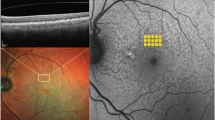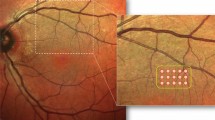Abstract
Background
For geographic atrophy (GA) due to age-related macular degeneration (AMD) there is so far no approved treatment option. Usually, increased autofluorescence (AF) levels of different patterns adjacent to the atrophic area indicate lipofuscin-laden retinal pigment epithelium (RPE) cells at a high risk for apoptosis. Herein, SRT was used to selectively treat these cells to stimulate RPE proliferation, in order to reduce or ideally stop further growth of the atrophic area.
Material and methods
Six eyes of six patients with bilateral equally pronounced GA were treated by SRT, while the fellow eye served as control. Irradiation was performed using a prototype SRT laser (Medical Laser Center Lübeck, Nd:YLF laser; 527 nm; 200 ns/1.7 µs pulse duration; 30 repetitive pulses at 100 Hz). Test lesions with increasing energies were applied at the lower vessel arcade to determine the individual angiographic and ophthalmoscopic threshold radiant exposures. Treatment was then performed in the area of increased AF adjacent to the GA using energies between both thresholds. The GA progression rates of treated and fellow eyes were evaluated.
Results
After a 1-year follow-up, a progression of the atrophic area was observed in the treated eyes (0.7–8.0 mm2/yr, mean 3.0 mm2/yr; 46%/yr) whereas the progression rates of the fellow eyes were insignificantly lower (0.46–4.04 mm2/yr, mean 1.9 mm2/yr; 30%/yr; p = 0.134). The progression rate in the treated eyes of two patients increased significantly, while in the other four patients, the progression rates were nearly the same between both eyes. Moreover, one of these two eyes showed an unexpected RPE reaction after treatment, since all laser lesions led to RPE atrophy and thus an accelerated enlargement of the GA occurred.
Conclusion
SRT in the hyperautofluorescent areas of GA was not able to stop or slow down the progression of GA. However, modified treatment strategies might be more promising, e.g. placing the spots outside the hyperautofluorescent areas where RPE apoptosis is postulated. Moreover, SRT studies on GA might be more successfully performed on specific subgroups of GA, based on autofluorescence and other findings.





Similar content being viewed by others
References
Klein R, Peto T, Bird A, Vannewkirk MR (2004) The epidemiology of age-related macular degeneration. Am J Ophthalmol 137(3):486–495
Klein R, Klein BE, Tomany SC, Meuer SM, Huang GH (2002) Ten-year incidence and progression of age-related maculopathy: the Beaver Dam Eye Study. Ophthalmology 109(10):1767–1779
Wang JJ, Rochtchina E, Lee AJ, Chia EM, Smith W, Cumming RG, Mitchell P (2007) Ten-year incidence and progression of age-related maculopathy: the Blue Mountains Eye Study. Ophthalmology. 114(1):92–98
Friedman DS, O’Colmain BJ, Munoz B et al (2004) Eye diseases Prevalence Research Group. Prevalence of age-related macular degeneration in the United States. Arch Ophthalmol 122:564–572
Kennedy CJ, Rakoczy PE, Constable IJ (1995) Lipofuscin of the retinal pigment epithelium: a review. Eye 9:763–771
Delori FC, Dorey CK, Staurenghi G, Arend O, Goger DG, Weiter JJ (1995) In vivo fluorescence of the ocular fundus exhibits retinal pigment epithelium lipofuscin characteristics. Invest Ophthalmol Vis Sci 36:718–729
Holz FG, Bellmann C, Staudt S et al (2001) Fundus autofluorescence and development of geographic atrophy in age-related macular degeneration. Invest Ophthalmol Vis Sci 42:1051–1056
Holz FG, Bindewald-Wittich A, Fleckenstein M, Dreyhaupt J, Scholl HP, Schmitz-Valckenberg S, FAM-Study Group (2007) Progression of geographic atrophy and impact of fundus autofluorescence patterns in age-related macular degeneration. Am J Ophthalmol 143(3):463–472
Roider J, Michaud NA, Flotte TJ, Birngruber R (1992) Response of the retinal pigment epithelium to selective photocoagulation. Arch Ophthalmol 110:1786–1792
Brinkmann R, Roider J, Birngruber R (2006) Selective retina therapy (SRT) - a review on methods, techniques, preclinical and first clinical results. Bull Soc Belge Ophtalmol 302:51–69
Wallow IH (1984) Repair of the pigment epithelial barrier following photocoagulation. Arch Ophthalmol 102:126–135
Del Priore LV, Glaser BM, Quigley HA, Green R (1989) Response of pig retinal pigment epithelium to laser photocoagulation in organ culture. Arch Ophthalmol 107:119–122
Framme C, Kobuch K, Eckert E, Monzer J, Roider J (2002) RPE in the perfusion culture and its response to laser application—preliminary report. Ophthalmologica 216(5):320–328
Roider J, Brinkmann R, Wirbelauer C et al (1999) Retinal sparing by selective retinal pigment epithelial photocoagulation. Arch Opthalmol 117:1028–1034
Roider J, Brinkmann R, Wirbelauer C, Laqua H, Birngruber R (2000) Subtreshold (retinal pigment epithelium) photocoagulation in macular diseases: a pilot study. Br J Ophthalmol 84:40–47
Framme C, Walter A, Prahs P, Regler R, Theisen-Kunde D, Brinkmann R (2009) Structural changes of the retina after conventional laser photocoagulation and selective retina treatment (SRT) in spectral OCT. Curr Eye Res 34:568–579
Framme C, Brinkmann R, Birngruber R, Roider J (2002) Autofluorescence imaging after selective RPE laser treatment in macular diseases and clinical outcome: a pilot study. Br J Ophthalmol 86(10):1099–1106
Elsner H, Liew SHM, Klatt C, Pörksen E, Bunse A, Rudolf R, Brinkmann R, Hamilton P, Birngruber R, Laqua H, Roider J (2006) Selektive Retina Therapie (SRT) bei Patienten mit diabetischer Makulopathie. Ophthalmologe 103(10):856–860
Elsner H, Pörksen E, Klatt C, Bunse A, Theisen-Kunde D, Brinkmann R, Birngruber R, Laqua H, Roider J (2006) Selective Retina Therapy (SRT) in patients with central serous chorioretinopathy (CSC). Graefes Arch Clin Exp Ophthalmol 244(12):1638–1645
Framme C, Schüle G, Roider J, Birngruber R, Brinkmann R (2004) Influence of pulse duration and pulse number in selective RPE laser treatment. Lasers Surg Med 34(3):206–215
Framme C, Walter A, Prahs P, Theisen-Kunde D, Brinkmann R (2008) Comparison of cell damage thresholds in selective retina treatment (SRT) using 200 ns and 1.7 µs laser pulses in patients with various macular diseases. Lasers Surg Med 40:616–624
Kracht D, Brinkmann R (2004) Green Q-switched microsecond laser pulses by overcoupled intracavity second harmonic generation. Optics Communications 231:319–324
Schüle G, Elsner H, Framme C, Roider J, Birngruber R, Brinkmann R (2005) Optoacoustic real-time dosimetry for selective retina treatment. J Biomed Opt 10:064022
Gabel VP, Birngruber R, Hillenkamp F (1978) Visible and near infrared light absorption in pigment epithelium and choroid. In: Shimizu K (ed) International Congress Series No. 450, XXIII Concilium Ophthalmologicum, Kyoto. Excerpta Medica, Princeton, NJ, pp 658–662
Framme C, Roider J (2004) Immediate and long-term changes of fundus autofluorescence in continuous wave laser lesions of the retina. Ophthalmic Surg Lasers Imaging 35:131–138
Klein R, Meuer SM, Knudtson MD, Klein BE (2008) The epidemiology of progression of pure geographic atrophy: the Beaver Dam Eye Study. Am J Ophthalmol 146(5):692–699
Sunness JS, Gonzalez-Baron J, Applegate CA, Bressler NM, Tian Y, Hawkins B, Barron Y, Bergman A (1999) Enlargement of atrophy and visual acuity loss in the geographic atrophy form of age-related macular degeneration. Ophthalmology 106(9):1768–1779
Sunness JS, Margalit E, Srikumaran D, Applegate CA, Tian Y, Perry D, Hawkins BS, Bressler NM (2007) The long-term natural history of geographic atrophy from age-related macular degeneration: enlargement of atrophy and implications for interventional clinical trials. Ophthalmology 114(2):271–277
Roider J, Brinkmann R, Wirbelauer C, Birngruber R, Laqua H (1999) Variability of RPE reaction in two cases after selective RPE laser effects in prophylactic treatment of drusen. Graefe´s Arch Clin Exp Ophthalmol 237:45–50
Acknowledgement
The authors would like to thank the Dr. Werner Jackstaedt Foundation in Wuppertal, Germany, for the generous financial support of this ongoing study.
Author information
Authors and Affiliations
Corresponding author
Additional information
Presented in part at the Annual Conference of the German Society for Ophthalmology (DOG), Berlin 2008
Rights and permissions
About this article
Cite this article
Prahs, P., Walter, A., Regler, R. et al. Selective retina therapy (SRT) in patients with geographic atrophy due to age-related macular degeneration. Graefes Arch Clin Exp Ophthalmol 248, 651–658 (2010). https://doi.org/10.1007/s00417-009-1208-1
Received:
Revised:
Accepted:
Published:
Issue Date:
DOI: https://doi.org/10.1007/s00417-009-1208-1




